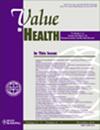标准电子临床结果评估与缩放电子临床结果评估的测量等效性:对临床试验中患者可及性的影响》。
IF 4.9
2区 医学
Q1 ECONOMICS
引用次数: 0
摘要
目的:临床试验中的多样性和包容性仍然是一个重要课题,尤其是对于视力障碍等残疾参与者而言。随着智能手机和平板电脑技术的进步,以及它们在临床试验中越来越多的应用,"捏合缩放 "等无障碍功能现在已变得触手可及。然而,在收集电子临床结果评估(eCOA)时使用此类无障碍功能并非没有风险,必须经过仔细考虑和科学测试,以确保不会影响数据的完整性。因此,本研究的目的是确定带有和不带有缩放无障碍功能的电子临床结果评估问卷的测量等效性,并测试其可用性:方法:按照电子COA最佳设计的行业标准,设计了一款具有缩放无障碍功能的电子COA应用程序。在随机交叉设计中,患有慢性疼痛或近期疼痛的参与者(n=53)在启用和未启用缩放无障碍功能的情况下完成了一份带有标准反应量表(口头评分量表 [VRS]、数字评分量表 [NRS]、视觉模拟量表 [VAS])的问卷调查。测定了类内相关系数(ICC)。一部分有视力障碍的参与者(10 人)参加了可用性测试访谈:ICC分析表明,在完成VRS、NRS和VAS时,缩放与非缩放之间的一致性很高(0.894-0.982)。参与者的可用性测试表明,缩放功能具有良好的易用性、读屏能力和实用性,尤其是在未佩戴视力矫正器的情况下:这些研究结果支持在临床试验中使用专门设计的 eCOA 缩放辅助功能。本文章由计算机程序翻译,如有差异,请以英文原文为准。
Measurement Equivalence of Standard and Zoom-Enabled Electronic Clinical Outcome Assessments: Implications for Patient Accessibility in Clinical Trials
Objectives
Diversity and inclusion in clinical trials remains an important topic, particularly for participants with disabilities such as vision impairment. With advances in smartphone and tablet technologies and their increasing use in clinical trials, accessibility features, such as pinch to zoom, are now at our fingertips. However, implementing such accessibility features when collecting electronic clinical outcomes assessments (eCOA) does not come without risks and must be designed with careful consideration and scientifically tested to ensure no impact to data integrity. Therefore, the objectives of this study were to determine the measurement equivalence of an eCOA questionnaire with and without a zoom accessibility feature and test its usability.
Methods
An eCOA app with a zoom accessibility feature was designed following industry standards for eCOA best design. Participants (n = 53) with chronic or recent pain completed a questionnaire with standard response scales (verbal rating scale, numerical rating scale, and visual analog scale), with and without the zoom accessibility feature enabled, in a randomized crossover design. Intraclass correlation coefficients were determined. A subset of participants (n = 10) with vision impairment participated in a usability testing interview.
Results
The intraclass correlation coefficients analysis showed high agreement (0.894-0.982) between zoomed and non-zoomed completions of the verbal rating scale, numerical rating scale, and visual analog scale. Participant usability testing showed good ease of use, ability to read the screen, and usefulness of the zoom feature, especially when not wearing corrective measures for vision impairment.
Conclusions
These findings support the use of a specially designed eCOA zoom accessibility feature for use in clinical trials.
求助全文
通过发布文献求助,成功后即可免费获取论文全文。
去求助
来源期刊

Value in Health
医学-卫生保健
CiteScore
6.90
自引率
6.70%
发文量
3064
审稿时长
3-8 weeks
期刊介绍:
Value in Health contains original research articles for pharmacoeconomics, health economics, and outcomes research (clinical, economic, and patient-reported outcomes/preference-based research), as well as conceptual and health policy articles that provide valuable information for health care decision-makers as well as the research community. As the official journal of ISPOR, Value in Health provides a forum for researchers, as well as health care decision-makers to translate outcomes research into health care decisions.
 求助内容:
求助内容: 应助结果提醒方式:
应助结果提醒方式:


